Synology DS923+ as a Storage Server for Kubernetes
Some services require persistent storage. You could use hostPath volume or local-storage storage class provided by k3s, but it couples the pod with the node. Longhorn fixes this problem by providing a distributed storage system, but I found it to be slow and unreliable on my low-end hardware. I decided to move my data to a dedicated storage server.
NAS Setup
My Synology DS923+ was delivered today, along with 2 Synology HAT3310-12T drives and an SNV3410-400G SSD for caching. I decided to use Synology because of their Synology Hybrid Raid (SHR). It allows you to seamlessly add more disks and create storage pools on drives with different sizes. They also provide Kubernetes CSI drivers, which was crucial for me.
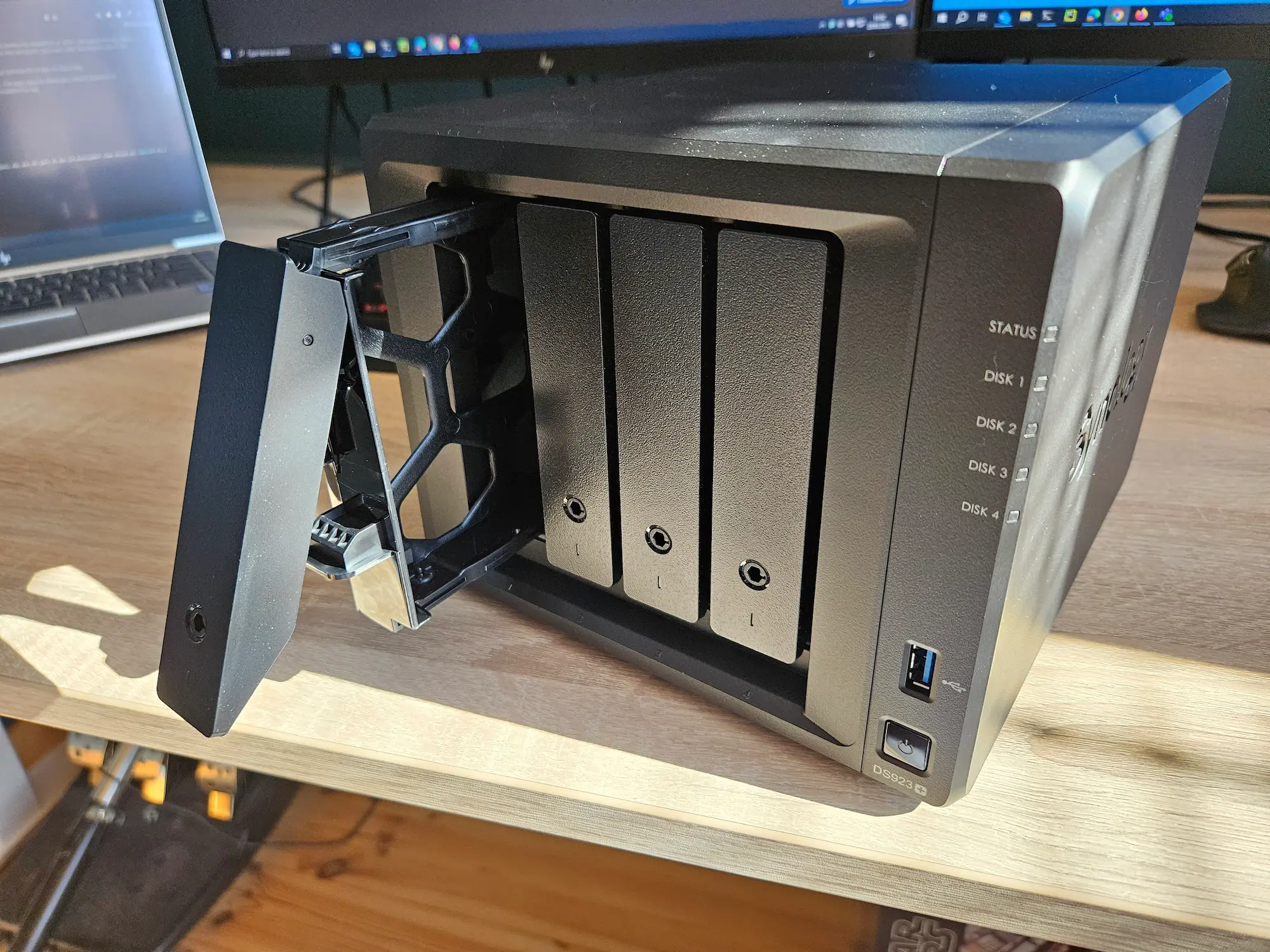
Reserving IP Addresses
After installing the drives, but before I connected the NAS to the network, I logged in to my router and reserved 2 IP addresses for the NAS. The DS923+ has 2 network adapters, so I reserved two IP addresses. I named the first one nas-1-1 and the second one will stay blank, until I connect it to the router.
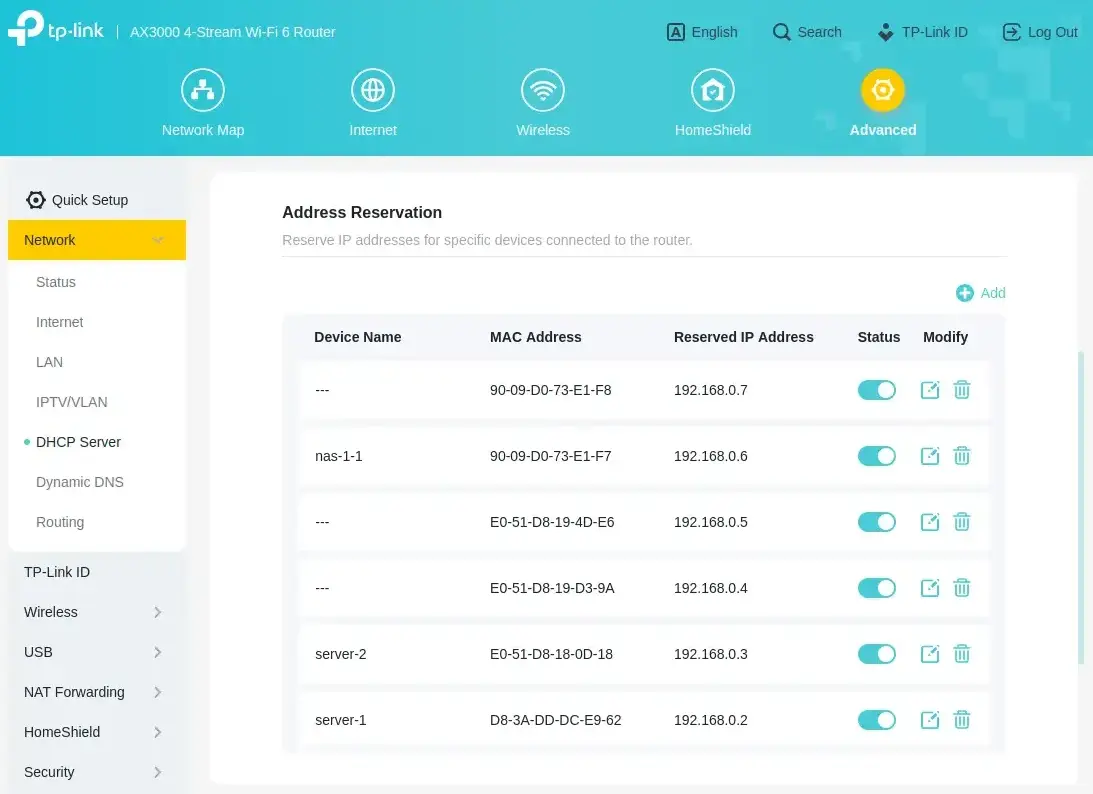
Connecting to the NAS
After starting the NAS, I opened https://finds.synology.com on my laptop and connected to the NAS.
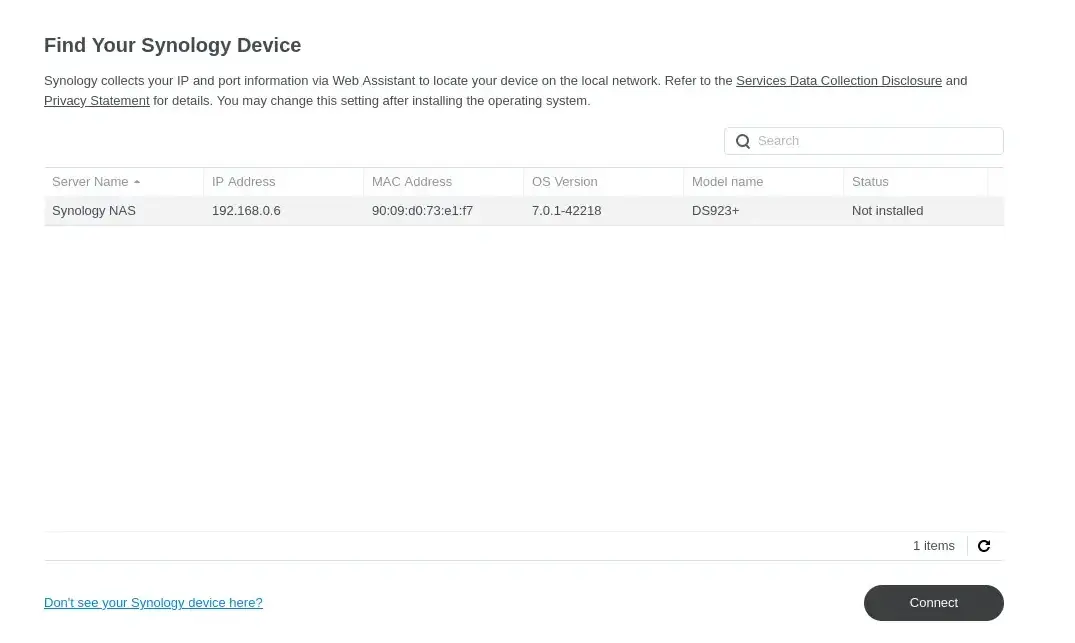
Initial Setup
Going through the wizard was quick and easy. I chose both of my disks, set the RAID type to SHR with 1 disk fault tolerance, and used the recommended Btrfs file system.
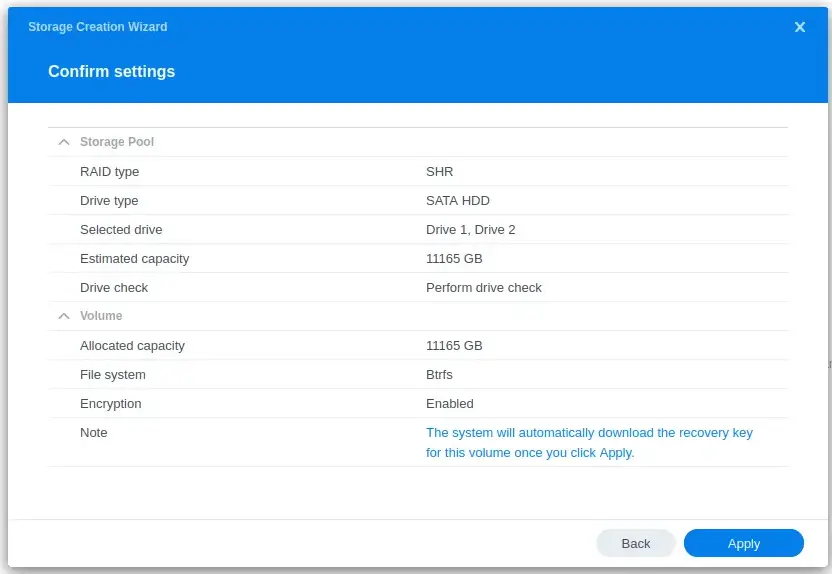
While I'm in the Storage Pool I also enable SSD Cache. Since I only have 1 SSD, I chose to use it as a read-only cache.

Running Drive Check
I also wanted to make sure that my drives were not damaged in transport, so I chose to run the drive check. It will take about 13 hours. I will come back to check the results later.
Creating a User for the CSI Driver
The last thing I needed to do was to create a user that will be used by the CSI driver. To do that, I opened the User & Group section under Control Panel. I named the user kubernetes so it's clear what it does. The account needs to be an administrator, so a strong password is a must.
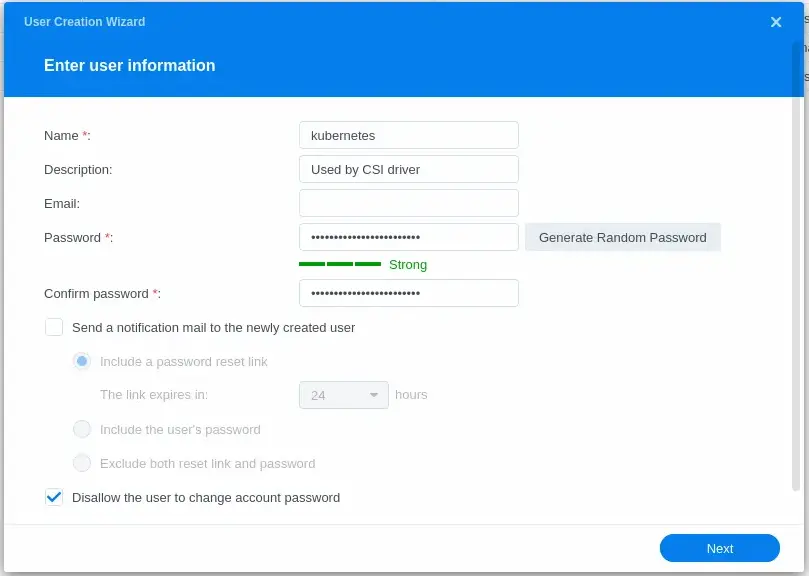
Installing CSI Driver for Kubernetes
With the drive check running, it's time to prepare the cluster for data migration. The Synology CSI Driver for Kubernetes is available on GitHub/SynologyOpenSource/synology-csi.
The instructions ask to clone the repository, create a client-config.yaml file, and run a script to deploy the driver. However, I'm using ArgoCD, so I want my configuration to be in manifests in my repository.
Creating Application Manifest
I'll start with the Application manifest:
apiVersion: argoproj.io/v1alpha1
kind: Application
metadata:
name: synology-csi
namespace: argocd
finalizers:
- resources-finalizer.argocd.argoproj.io
annotations:
argocd.argoproj.io/sync-wave: "-30"
spec:
project: default
source:
path: manifests/base/synology-csi
repoURL: 'https://github.com/theadzik/homelab'
targetRevision: HEAD
destination:
server: https://kubernetes.default.svc
syncPolicy:
automated:
prune: true
selfHeal: true
Then I copied the contents of deploy/kubernetes/v1.20 directory to my repository under manifests/base/synology-csi.
Configuring Client Info
Now I needed to pass client-info configuration to the driver. It feels a bit weird that my NAS configuration goes into the clients section, but that is correct. I saved the file in manifests/base/synology-csi/configs/client-info-secret.yml.
clients:
- host: "192.168.0.6"
port: 5000
https: false
username: "kubernetes"
password: "correct-horse-battery-staple"
I use git-crypt to encrypt secrets in my repository and a custom ArgoCD image that can decrypt them. Don't put unencrypted secrets in your repository.
Editing Storage Class and Volume Snapshot Class
Now we need to edit storage-class.yml to match our storage pool. I want to have 2 storage classes, one with Retain and one for Delete policy. Both of them should be using the btrfs file system type.
apiVersion: storage.k8s.io/v1
kind: StorageClass
metadata:
name: synology-iscsi-retain
annotations:
storageclass.kubernetes.io/is-default-class: "true"
provisioner: csi.san.synology.com
parameters:
fsType: 'btrfs'
formatOptions: '--nodiscard'
reclaimPolicy: Retain
allowVolumeExpansion: true
---
apiVersion: storage.k8s.io/v1
kind: StorageClass
metadata:
name: synology-iscsi-delete
annotations:
storageclass.kubernetes.io/is-default-class: "false"
provisioner: csi.san.synology.com
parameters:
fsType: 'btrfs'
formatOptions: '--nodiscard'
reclaimPolicy: Delete
allowVolumeExpansion: true
formatOptions: '--nodiscard' is important. Without it, I was not able to mount a drive bigger than a few GB.
I made the Synology VolumeSnapshotClass default in volume-snapshot-class.yml.
apiVersion: snapshot.storage.k8s.io/v1
kind: VolumeSnapshotClass
metadata:
name: synology-snapshot-class
annotations:
storageclass.kubernetes.io/is-default-class: "true"
driver: csi.san.synology.com
deletionPolicy: Delete
parameters:
description: 'Kubernetes CSI'
is_locked: 'false'
Installing CRDs
Lastly, we need to make sure we have CRDs installed for our snapshotter. We can add a link to the git repo directly in our kustomization.yaml file.
apiVersion: kustomize.config.k8s.io/v1beta1
kind: Kustomization
namespace: synology-csi
resources:
- github.com/kubernetes-csi/external-snapshotter/client/config/crd?ref=v8.2.0
- controller.yml
- csi-driver.yml
- namespace.yml
- node.yml
- storage-class.yml
- snapshotter/snapshotter.yml
- snapshotter/volume-snapshot-class.yml
secretGenerator:
- name: client-info-secret
files:
- client-info.yml=configs/client-info-secret.yml
I'm using kustomize to generate the secret from the file. To automatically encrypt secrets, I need to add "secret" to the name. The driver expects the key in the secret to be named client-info.yml, so I had to rename the file in the secretGenerator section.
I pushed the changes to my repository and waited for ArgoCD to deploy the driver.
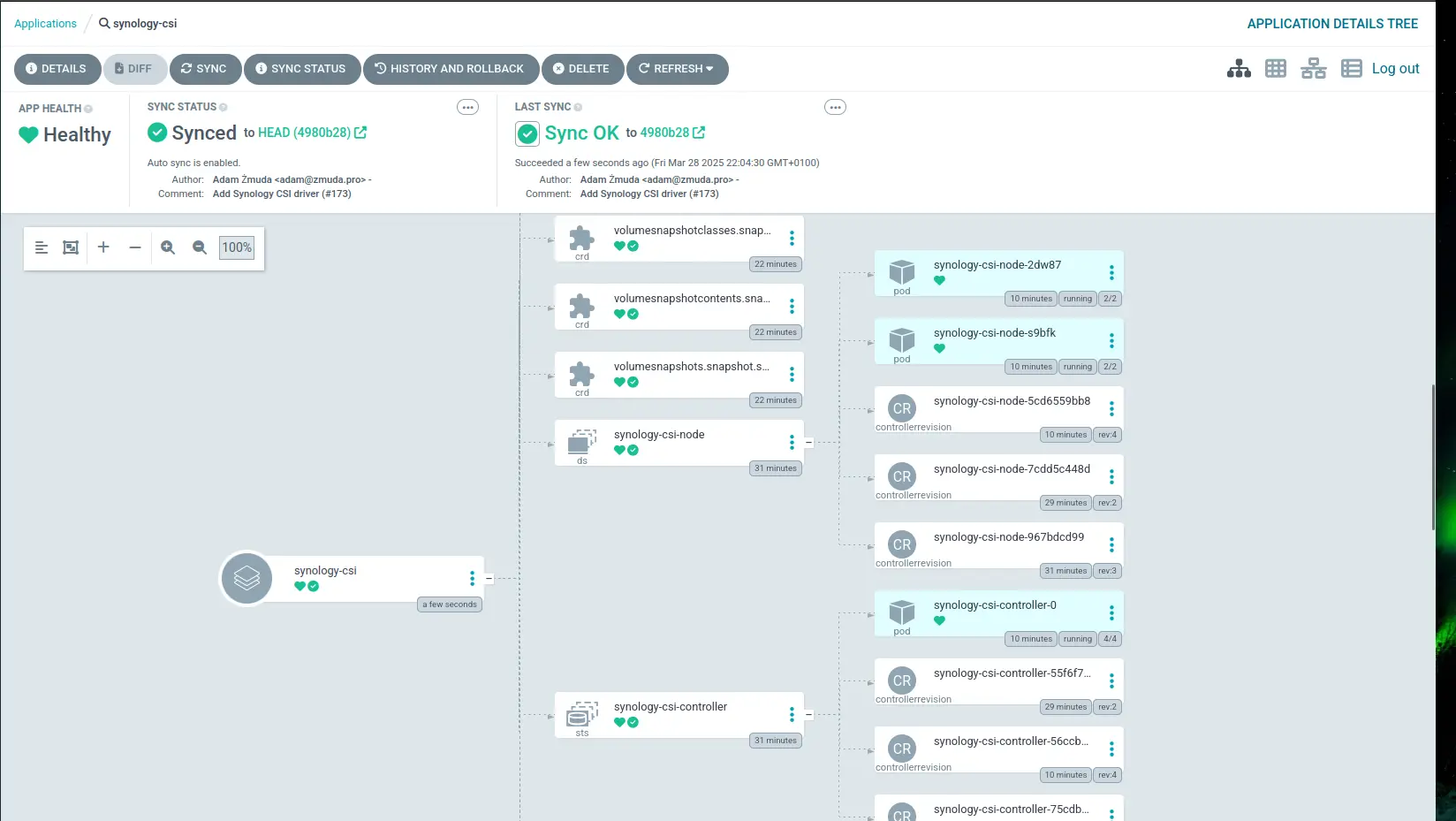
Testing
Once done, I could test if everything works by creating a PVC:
apiVersion: v1
kind: PersistentVolumeClaim
metadata:
name: test
namespace: test
spec:
accessModes:
- ReadWriteMany
resources:
requests:
storage: 2Gi
storageClassName: synology-iscsi-delete
$ k apply -f test.yaml -n test
persistentvolumeclaim/test created
$ k get pvc -n test
NAME STATUS VOLUME CAPACITY ACCESS MODES STORAGECLASS VOLUMEATTRIBUTESCLASS AGE
test Bound pvc-0f0fcd10-c81e-43c7-a325-600f970c2508 2Gi RWX synology-iscsi-retain <unset> 73s
Looks like everything is working, but let's check Synology to make sure the volume was created.

Success! The volume was created and is ready to be used.
Link to code
You can find the whole code in my repository
